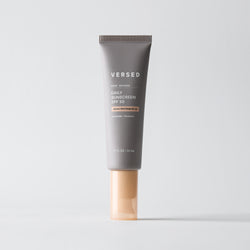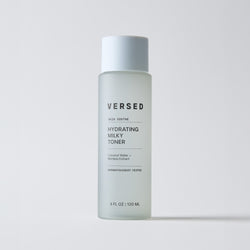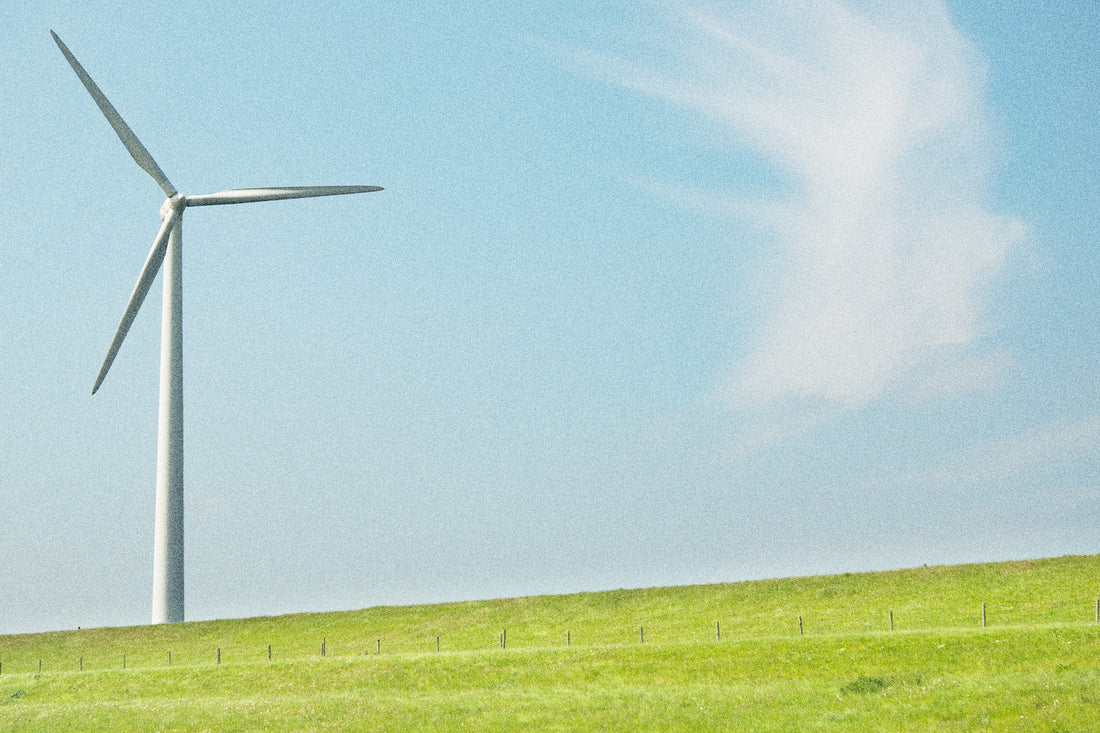The first step to climate action, however, is education. How can you recycle properly if you don’t understand the type of plastic you’re tossing? What are carbon sinks, and why should we help preserve them? What does the label “climate neutral” actually mean? Hold it right there, Google. We’ve got you. Check out easy-to-understand definitions for the most common sustainability terms below. Tip: Use command/control + F to search for a particular word you’re confused about.
A
ACIDIFICATION
Most commonly spoken about in reference to the ocean, ‘acid rain’, or soil, acidification is when a resource’s pH decreases and becomes more acidic. This process is primarily caused by fossil fuels and hurts various ecosystems, such as marine life.
ALTERNATIVE ENERGY
Alternative energy is energy created from renewable or otherwise “green” sources. Some examples of alternative energy are hydroelectric, solar, and wind energy. Though not renewable, nuclear energy is considered by some as a form of alternative energy because little to no carbon emissions are created through this process. Alternative energy seeks to alleviate the environmental repercussions of conventional energy production.
B
BIODEGRADABLE
A material that naturally decomposes into the Earth on its own. Anything labeled biodegradable should break down in a “reasonable amount of time”, but we don’t always know how long that process takes. Biodegradable materials aren’t necessarily beneficial; some may release methane into the atmosphere as it decays. If it is beneficial to the Earth, it is considered compostable (more on that later).
BIOFUEL
A source of renewable energy derived from biomass that’s considered an alternative to fossil fuels.
BIOMASS
Plant and animal materials (such as waste) that can be used as biofuel.
BIODIVERSITY
Also known as biological diversity, biodiversity is a variety of life on earth—from plant and animal species to habitats and ecosystems. A lack of biodiversity means depleted resources that are necessary for survival, contributing to endangered species and more.
BIOMIMICRY
Biomimicry is a design philosophy that encourages the imitation of natural systems and structures in human creations by mimicking natural forms and shapes, including natural processes and entire ecosystems. The concept of a circular economy is an example of biomimicry, in which the economy mimics nature’s cyclical model of renewal and reuse.
BLACKWATER
A type of contaminated wastewater sourced from toilets, kitchen sinks, and dishwashers (basically, sewage water). Through water treatments, however, blackwater can be reused and recycled, reducing water waste and conserving energy.
BPA
You’ve probably seen the term BPA-free, but what does that mean? BPA stands for bisphenol A, a chemical that is used when creating polycarbonate (PC) plastics—the same #7 plastic found in baby bottles and sippy cups. This type of plastic is not easily recycled but, beyond that, research says it can seep through into food and drinks, exposing humans and infants to serious health risks.
BROWN MATERIAL
Dry, carbon-rich materials that can be composted. Some examples of brown materials include leaves, dryer lint, and shredded paper bags. These are necessary for composting for aeration purposes (allowing water and air to move instead of sitting in a soggy mess).
BYPRODUCT
Excess material produced. This can range from something as innocuous as sawdust from sawing wood to carbon dioxide from gasoline.
C
CAP AND TRADE
A cap and trade program gives a finite amount of carbon credits (more on that below) to organizations that frequently pollute. Once their cap is reached, they can not use any more credits, preventing them from releasing any more carbon into the atmosphere. Companies with an excess number of credits can then sell their surplus to those that need it, giving a financial incentive to those that emit less. While these programs aren’t yet widely adopted, the US Clean Air Act of 1990 is considered the world’s first cap and trade program.
CARBON CREDIT
Used in cap and trade programs, one credit equals one tonne of carbon dioxide emitted into the atmosphere. Good to know: Carbon credits are sometimes used interchangeably with the term carbon offset, however, they’re not exactly the same (more on that below).
CARBON DIOXIDE
You’ve probably seen this colorless, odorless greenhouse gas written as CO2. Two parts carbon, one part oxygen, CO2 isn’t all bad. In fact, it’s necessary for our own survival since plants need it for photosynthesis, which in turn becomes food for other species (including ourselves). We breathe out carbon dioxide constantly. Too much carbon dioxide, however, is detrimental to our planet and contributes to global warming.
CARBON OFFSET
Similar to a carbon credit, one carbon offset is equivalent to one tonne of carbon dioxide emitted into the atmosphere. Purchasing one carbon offset, therefore, can be explained as removing one tonne of CO2 from the atmosphere, as that money is given to programs that reduce greenhouse gas emissions by planting trees, creating wind energy, or more. To ensure your purchase is going to these projects, it’s vital to purchase certified credits (CER) through the United Nations or the like. While carbon offsets can help rebalance the atmosphere, it’s important to remember they don’t reduce emissions. Additionally, this term is limited to just carbon dioxide and excludes other dangerous greenhouse gases, like methane.
CARBON FOOTPRINT
The amount of carbon released by a person or organization is known as their carbon footprint. In general, a “footprint” should refer to all emissions—not just carbon.
CARBON NEUTRAL
Achieving carbon neutrality means emitting net-zero carbon emissions, typically by offsetting. That’s where carbon neutrality falls short, however; it doesn’t take into account all the other greenhouse gas emissions. It also doesn’t effectively reduce emissions, just rebalances the atmosphere.
CARBON SINKS
Anything that naturally absorbs and removes CO2 from the atmosphere. Oceans, plants, and soil are examples of carbon sinks.
CARBON TAX
A government operation that incentivizes companies to reduce their greenhouse gas emissions through a tax. Finland, Sweden, and Norway use a carbon tax system.
CER
The acronym for Corporate Environmental Responsibility, a company’s CER takes ownership of the environmental impact its organization has on the planet.
CfRN
This stands for the Coalition for Rainforest Nations, an organization that works to reduce deforestation and preserve these vital ecosystems.
CIRCULAR ECONOMY
A circular economy is an economic model that envisions a closed system of continual resource use. The goal is to reduce waste, reuse or up-cycle what we have, and recycle those elements that cannot be reused. This redesign of the current operating system finds its roots (no pun intended) in nature’s cyclical model, where there exists a continual cycle of renewal and reuse, and where the concept of waste as an end product doesn’t exist. Indeed, it becomes a valuable resource, as “food” for something else.
CITES-CERTIFIED
The Convention on International Trade in Endangered Species of Wild Fauna and Flora (CITES) was created in the 1970s. It’s an agreement that ensures international trade between governments does not harm endangered plants. A CITES-certified ingredient (like the mica found in our Smoothing Eye Cream) means its usage doesn’t threaten the species survival.
CLEAN ENERGY STANDARD (CES)
Sometimes called a clean electricity standard, CES requires a percentage of electricity to come from ‘clean’ or low-emitting sources. Similar to a cap and trade program, a CES is used as an incentive for companies and suppliers to use more green energy and fewer fossil fuels.
CLIMATE ACTION
Any measurable movement taken by an individual, company, or organization to reduce their greenhouse gas emissions and control global warming. For more, read our Climate Action Plan.
CLIMATE CHANGE
Also known as global warming, climate change refers to a shift in Earth’s temperature and is largely attributed to human-made greenhouse gas emissions. Over time, climate change causes extreme shifts in weather, natural disasters (such as hurricanes and wildfires), low water supply, and more.
CLIMATE NEUTRAL
Climate neutral and carbon neutral are often used interchangeably, but there is a key difference: Carbon neutrality refers to net-zero CO2 emissions while climate neutrality includes all greenhouse gas emissions, such as nitrous oxide and methane. Brands that reach net neutrality by reducing and offsetting their emissions can apply for certification.
CLIMATE NEUTRAL NOW PLEDGE
An initiative created by the UN in 2015 to encourage companies and individuals to commit to reducing their own carbon footprints, as well as fight back against climate change.
CLIMATE POSITIVE
Exceeding achieving carbon neutrality by removing additional carbon dioxide from the atmosphere; also referred to as carbon negative.
CLOSED-LOOP RECYCLING
An indefinite form of recycling where a product’s raw materials are broken down and used to create a similar product again and again without creating much waste. Aluminum cans are an example of closed-loop recycling.
COMPOST
Composting is an eco-friendly alternative to simply throwing items like food scraps in the trash bin, where they would otherwise end up in the landfill. These scraps (both green and brown material) are added to a bin where they decompose into nutrient-rich soil (known as black gold) and are added back into the Earth.
COMPOSTABLE
A biodegradable material that breaks down naturally, benefitting Earth’s soil. Note: Compostable items are also biodegradable (but not everything biodegradable is compostable). Compostable items also decay at a much faster pace (typically 90-120 days) than biodegradable ones.
CONSERVATION
Conservation is a philosophy that calls for the protection of natural landscapes, wildlife, or resources. Governments often play a role in conservation by passing laws that prohibit the extraction or utilization of resources or land in certain areas.
CO2E
Or carbon dioxide equivalent. CO2E is a simple way to describe several greenhouse gases as one unit, measured as having the same warming potential as carbon dioxide.
CRADLE TO CRADLE
Using the end-use product (‘waste’) for the source of a new product. Instead of manufacturing a product from scratch, all products can be designed for continuous recovery and re-utilization.
CRADLE TO GATE
A term that considers the environmental impact of an item from its creation to when it reaches a store’s shelf or can be sold.
CRADLE TO GRAVE
Unlike cradle to gate, this assessment acknowledges the entire life cycle of an item from start to finish. Those that evaluate their products’ environmental impact from cradle to grave will consider everything from ingredient sourcing and manufacturing to disposal and breakdown.
CRUELTY-FREE
Not-so-fun fact: Cruelty-free isn’t a term regulated by the FDA. It generally, however, refers to formulas that haven’t been tested on animals. The specifics get fuzzy, however, which is why it’s so difficult to shop for products that are certified through cruelty-free programs. Psst: Versed is certified cruelty-free through Leaping Bunny.
D
DECOMPOSE
Decomposition is a biological process where organic matter breaks down into more simple forms. Products that are able to decompose are considered safer for the environment because they have a shorter lifespan when compared to products that do not decompose. Inorganic materials such as plastic take many thousands of years to decompose. Composting is an intentional form of decomposition.
DEFORESTATION
The removal of trees, typically in tropical rainforests. Deforestation contributes to climate change, as plants remove carbon dioxide from the atmosphere. It also destroys ecosystems and threatens the livelihood of indigenous peoples.
DISPOSABLES
Products designed to be thrown away after a single use or a few uses.
DOWNSTREAM EMISSIONS
A Scope 3 emission indirectly related to a customer (as opposed to upstream, which refers to the supplier). An example of a downstream emission is a customer tossing a product in the trash, which ends up in the landfill and releases carbon dioxide into the atmosphere.
E
ECO-CONSCIOUS
Similar to eco-friendly, this is an unregulated term that refers to any person, organization, object, or company that considers the environment in some capacity.
EMISSIONS
In sustainability, an emission is a greenhouse gas that is released into Earth’s atmosphere, damaging the planet. Emissions fall into three different buckets, referred to as scopes: Scope 1 are direct emissions controlled by an organization (e.g. shipping online orders), Scope 2 are indirect emissions that are controlled by an organization (e.g. the electricity used in a warehouse), and Scope 3 are indirect emissions that are not in control of an organization (e.g. customers tossing empty products in the trash). Scope 3 emissions are the most difficult to quantify.
END OF LIFE
In a life cycle assessment, a product or material’s end of life refers to how it is disposed of, including recyclability and decomposition.
ENERGY-EFFICIENT
A term describing any product or process that uses as little energy as possible to reduce emissions and cut back on pollution.
EPA
The Environmental Protection Agency is a federal government agency implemented during the Nixon presidency tasked with protecting our health and planet.
ECOSYSTEMS
A community of living and non-living species that interact and coexist within an environment.
ENDANGERED SPECIES
An animal or plant species that are at risk for extinction. As of 2021, there are over 16,000 endangered species.
EXTINCTION
The termination of an organism. Extinction typically refers to an entire species dying out, for a variety of reasons, with the inability to return.
F
FAIRTRADE CERTIFICATION
Fairtrade certification is a product certification method carried out by a third-party organization. The certification sets standards for the production of goods without the economic exploitation of producers and ensures that producers are paid a living wage.
FOREST DEGRADATION
While deforestation refers to removing large areas of trees for non-forest use, forest degradation speaks to ecosystems breaking down over time, losing their ability to provide the benefits they once offered, such as providing animals a place to live or filtering our air.
FOSSIL FUEL
A type of fuel formed from plant and animal fossils (or the remains of organisms that existed millions of years ago). There are four types of fossil fuels: petroleum, coal, natural gas, and orimulsion. Fossil fuels have a high carbon content, which causes them to be dangerous when burned, resulting in climate change, ocean acidification, pollution, and more. Green energy is considered to be an alternative to fossil fuels.
FSC
Also known as the Forest Stewardship Council, the FSC is in charge of protecting these precious resources from deforestation and degradation, one way being through their certification. A product that is FSC-certified has been vetted by this council and ensured that its paper was sourced in an ethically responsible manner by not using hazardous chemicals, disturbing indigenous cultures, endangering environments that are considered rare, and more. All Versed paper packaging uses 100% FSC-certified paper.
G
GLOBAL WARMING
Used interchangeably with climate change, global warming refers to the increase in Earth’s temperature over time as a result of increased greenhouse gas emissions.
GREENHOUSE EFFECT
Attributed as a cause for global warming, the greenhouse effect refers to the sun’s heat becoming trapped in Earth’s atmosphere due to an increase in gases, like methane. See more below.
GREENHOUSE GAS (GHG)
These gases trap heat in Earth’s atmosphere, warming the planet and leading to climate change. There are six major types: Water vapor, carbon dioxide, methane, ozone, nitrous oxide, and chlorofluorocarbons.
GREEN MATERIAL
The ‘greens’ in composting (not necessarily related to their actual color) are wet, nitrogen-rich scraps that help spur microbial growth, breaking materials down and creating compost. Examples include banana peels, coffee grinds, grass clippings, and dead flowers.
GREENWASHING
Sometimes called ‘green sheen’, greenwashing is misleading others when speaking about one’s own environmental impact. For example, a company that uses vague terms without any scientific evidence to make it seem more eco-conscious than it actually is. As a consumer, it can be tricky to avoid falling into a greenwashing trap. Support organizations that back up their words with verified numbers and facts and question terms that aren’t regulated, such as green, eco-friendly, and all-natural.
H
HDPE
This #2 plastic stands for High-Density Polyethylene. You’ll typically find this highly recyclable plastic in milk jugs, laundry detergent, shampoo bottles, and plastic bags.
HUMUS
The ‘black gold’ that results from composting, humus is nutrient-rich and can be added back into the Earth to fertilize the soil. You’ve created humus when all scraps are broken down, leaving dark, crumbly dirt behind.
HVAC
HVAC is the acronym for heating, ventilation, and air conditioning. HVAC systems are some of the most energy-intensive systems within the built environment. Investing in building insulation can reduce the need for large, energy-intensive HVAC systems.
I
INSETTING
Instead of looking to external partners to offset emissions, carbon insetting implements strategies to help measure and reduce emissions internally via incremental changes to operations, packaging, manufacturing, and more.
L
LANDFILL
A dump, if you will, where waste is deposited. Landfills are harmful because they release greenhouse gases and toxic chemicals into our air and water supply. Recycling, reusing items, and composting are just some ways to keep waste out of landfills.
LDPE
Low-density polyethylene or a #4 plastic. LDPE is typically used in packaging coating (like on your coffee cups), container lids, and plastic bags. #4 plastics are not easily recycled.
LEAPING BUNNY
A cruelty-free certification that ensures a product has not been tested on animals. Leaping Bunny also conducts its own audit, requires additional compliance from a brand’s third-party suppliers, mandates an annual recommitment, and does not allow products to be sold in any country where animal testing is required. All Versed products are proudly Leaping Bunny certified.
LIFE CYCLE ANALYSIS (LCA)
An analysis of a product’s environmental impact from cradle to grave. There are typically six stages included: material extraction, manufacturing. packaging, transportation, use, and end of life.
M
METHANE
One of the greenhouse gases, methane (or CH4) is odorless, colorless, and highly flammable.
MICROPLASTICS
According to the National Ocean Service, any plastic smaller than 5mm—about the size of a seed—is considered a microplastic. These teensy tiny bits of plastic come from cosmetics (like microbeads found in scrubs), clothing fibers, manufacturing materials, and more. Because they are so small, microplastics easily filter into our oceans where they are consumed by fish. Not only do microplastics harm marine life, but they pollute our water supply, too.
N
NET-NEUTRAL
When it comes to our climate, net-neutral or net-zero refers to the ideal balance of emissions where all the greenhouse gases emitted into the atmosphere are negated by the number of GHGs offset. Currently, the US has a goal of achieving net neutrality by 2050.
NON-RENEWABLE RESOURCE
A finite resource that cannot be replenished quickly enough to keep up with its high consumption rate. Coal, oil, and natural gas are some examples of non-renewable resources.
O
OFFSETCounteracting one act by doing the opposite. In sustainability, offsetting refers to purchasing carbon credits to offset the number of GHG emissions released into the atmosphere. For more, see carbon offset.
ORGANIC
Technically, any living thing is considered organic. When it comes to formulas and ingredients, however, an organic label (like on produce) signifies it was made without the use of fertilizers and pesticides. Because organic farming doesn’t use chemicals, it is considered to be more sustainable and better for the planet, saving energy, reducing pollution, and avoiding land erosion.
P
PC
Polycarbonate is the most common type of #7 plastic (other). It is not typically accepted at recycling programs and it is often created using BPA, a chemical that can negatively impact our health.
POST CONSUMER RECYCLED (PCR)
Or, post consumer recycled material (often plastic). When we recycle an item, its materials are broken down and reused to make new products, eliminating the waste it’d create if it simply went to decompose in a landfill (which, by the way, can take hundreds of years). Products that are made with PCR use less virgin plastic and don’t create as much waste. Versed’s product lineup is currently 50% PCR by weight.
PEG
PEG stands for Polyethylene Glycol, a type of microplastic derived from petroleum that can pollute our oceans and harm marine life.
PET
You’ve probably seen the words PET or PETE on a plastic bottle at some point or another. Polyethylene terephthalate (PET) is a type of polyester used in #1 plastic packaging. PET became popular in the 1970s for being light, inexpensive, and recyclable. But recycling rates remain low (only 9% of plastic gets recycled) and PET bottles create 100x more emissions than glass versions.
POST INDUSTRIAL RECYCLED (PIR)
When a product is created using waste left behind during the manufacturing process (also known as post-industrial or pre-consumer waste), it was made using post industrial recycled content. For example, scraps or ‘pinch-off’ left behind from creating a plastic jug can be saved and used to manufacture something else.
PLASTIC
A type of synthetic material made from polymers (like polyethylene). Plastic material is moldable, cheap, and lightweight but has a detrimental effect on the environment since it does not easily break down. In fact, it takes over 450 years for a single plastic bottle to decompose. There are 7 types of plastics that you’ll see labeled with a resin identification number (that engraving found within a triangle on the bottom of your plastics).
POLYETHYLENE
Also spelled polythene or abbreviated to PE, polyethylene is the most common type of plastic used, mostly in packaging.
POLLUTION
Pollution is any contaminant that infiltrates our environment with the ability to harm the planet and its inhabitants. Most of us think of litter when we hear pollution, but there are several types: air, water, land, radioactive, thermal, light, and sound pollution.
POLYPROPYLENE
A #5 plastic that is typically used in hot food containers, since it is strongly resistant to heat. #5 plastics are sometimes accepted at recycling programs, so check locally before tossing.
PVC
The #3 type of plastic, which stands for Polyvinyl Chloride. PVC is known to be the most toxic, hazardous type of plastic. You’ll find it in cling wrap, binders, and tubing. PVC is rarely accepted in curbside recycling programs.
POLYSTYRENE
Sometimes abbreviated to PS, this is a #6 plastic that is used for styrofoam containers. #6 is almost never accepted at recycling programs.
R
RECYCLABLE
Any material that can be broken down into raw materials to create something new. Recycling reduces waste, conserves energy, and prevents pollution. The problem? Only 9% of plastic gets recycled. On top of that, recycling guidelines vary from city to city—something recyclable in one area isn’t in the next. Plus, recyclable items must be empty, rinsed, and sometimes disassembled. To prevent ‘wishcycling’ (check out that definition next), check your city’s local recycling guidelines before you toss. For more tips, read our guide to recycling your items.
RECYCLED CONTENT
Anything made with recycled content uses material that was previously recycled, such as PCR plastic. Good to know: Recycled content is not the same as recyclable, so always check before you toss it in the blue bin.
REEF-SAFE
Reef-safe or reef-friendly is an informal term used to describe any product, ingredient, or practice that doesn’t harm coral reefs. It’s mostly used to describe sunscreen, as chemicals found in many SPF formulas can cause coral bleaching, leading to this species’ decline in health. Reef-safe is not a regulated term, but any sunscreen made without oxybenzone and octinoxate is generally considered reef-safe.
REFORESTATION
Replanting trees as a solution to deforestation, which harms our planet and causes climate change (among other problems).
REGENERATIVE AGRICULTURE
Regenerative agriculture is a form of agriculture that emphasizes the remediation of depleted soils through organic and non-synthetic processes. Regenerative agriculture goes beyond sustainable agriculture by improving ecosystems rather than trying to maintain them. This form of agriculture rejects pesticides and synthetic fertilizers and instead seeks to mimic natural cycles.
RENEWABLE RESOURCE
Also called a flow resource, renewable resources are naturally able to replenish before they are depleted. Solar and wind energy are examples of renewable resources.
RESIN IDENTIFICATION NUMBER
The number listed on the bottom of plastic items, signaling the type of plastic it is made of. #1 (PET/PETE), #2 (HDPE), and #5 (PP) plastics are accepted at most curbside recycling programs. #3 (PVC), #4 (LDPE), #6 (PS), and #7 (other) plastics are not always able to be recycled, so always check your local city’s guidelines before tossing.
S
SCIENCE-BASED TARGETS
Science-based targets are used when organizations develop goals for reducing their greenhouse gas emissions. What makes them ‘science-based’, however, is that they coincide with what science tells us is necessary to make a positive impact on global warming. The Paris Agreement states global warming should be limited to below 2°C above pre-industrial levels; a company’s science-based target will adhere to that number when calculating goals.
SINGLE-USE
Any disposable item that can not be recycled or reused, such as a cotton swab. Single-use products create waste and typically end up in a landfill. Whenever possible, swap single-use items for reusable ones instead.
SUSTAINABILITY
According to the United Nations, sustainability means meeting the needs of the present without compromising the ability of future generations to meet their own needs. We use sustainability most often to speak about preserving the health and longevity of our planet.
Our concept of sustainability must encompass impacts across climate, waste, water, air, biodiversity, and social inclusion, says the United Nations' Department of Economic and Social Affairs. A product or company is not sustainable unless all aspects of its impact are sustainable. Because the term isn’t regulated, be wary of greenwashing when you come across it as many use the term quite loosely.
SPEND-BASED METHOD
A way to calculate emissions based on their monetary value (e.g. emissions per dollar spent). This method multiplies the economic value of a good or service by the industry average emission factors.
T
TONNE
Not to be confused with ‘ton’, a tonne is a metric measurement of weight often used when speaking about carbon emissions. 1 tonne = 1000kg = 2,204.6 lbs.
U
UPSTREAM EMISSIONS
A type of Scope 3 emissions, upstream refers to anything related to a supplier (as opposed to downstream, which refers to the user). An example of an upstream emission is methane being released at a third-party manufacturer.
V
VEGANISM
The practice of abstaining from animal-sourced ingredients, including meat and dairy. Vegan products use less water and emit fewer emissions than non-vegan products, reducing your footprint by up to 73%. Versed products only use 100% vegan ingredients.
VIRGIN PLASTIC
New, never-before-used plastic. Virgin plastic is essentially the opposite of PCR (recycled plastic).
W
WASTE STREAM
The entire flow or cycle of waste that a person or organization is responsible for. There are two types: material-related waste streams (such as plastic) and product-related waste streams (like batteries).
WISHCYCLING
Tossing something in the recycling bin hoping it’ll get recycled without actually knowing whether it can be, thus contaminating the stream of truly recyclable items. Think before you toss!
Z
ZERO WASTE
Any act, process, or product that creates—you guessed it—zero waste. Like the term ‘greenwashing’, zero waste is one of those concepts to be wary of. Because most processes produce some waste‚ including factors you may not think about like carbon dioxide emissions and water—it’s incredibly difficult to produce zero waste. Companies and organizations that claim to do so could be overpromising, so always take a critical eye to the term when you come across it.








